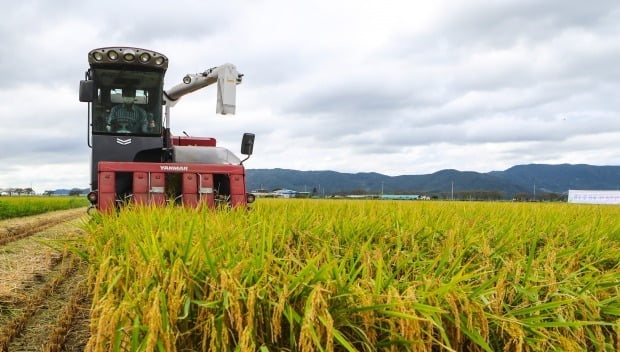
Photo = Yonhap News
The price of rice, the number one item in price management, is fluctuating. Both wholesale and retail prices have risen 20% in one year. Considering that the government is intervening in the rice market through public procurement, this is large. The biggest reason is that production has declined due to the reduction in rice cultivation area. One of the reasons was that productivity declined due to the long rainy season that struck last summer, but rather, the’rice paddy crop cultivation project’, which has been held in farms nationwide for the past three years, was found to be the key cause.
The growing area of rice decreases
Rice prices have risen in both wholesale and retail prices. According to the Korea Agriculture and Fisheries Food Distribution Corporation, on the 15th, the retail price of 20 kg of rice (products) was 6,184 won, up 17.6% from the same period last year (56,64 won). During the same period, the wholesale price of 20 kilograms of rice rose 21% from 47,100 won to 5,7380 won. Food companies were unable to withstand the cost burden and raised the factory price of instant rice products such as Hetbahn and Ottogibap by 5-7% at the end of last month.
The biggest reason for the rise in rice prices is a decline in rice production. According to data submitted by the Ministry of Agriculture, Food and Rural Affairs, Lee Man-hee, a member of the National Assembly’s Agriculture, Forestry, Livestock, Food and Marine and Fisheries Committee, the rice cultivation area from 770,834 ha (ha) in 2016 decreased by 6.7% in 5 years. . Rice production decreased by 16.4% from 4.19 million tons to 3.5 million tons during the same period. In this year’s Agricultural Outlook Report, the Rural Economic Research Institute explained that “the rice cultivation area has decreased by 2.0% on an annual average since 2010 due to the aging of farm households, urban development, and the conversion of rice paddy crops.”

Photo = News 1
Government overturned after saying, “Sow beans in rice fields”
The reason behind the decline in rice production is government intervention. The government had to intentionally reduce rice production. Due to the WTO agreement, the government is obligated to import 409,000 tons of rice each year, and at the same time purchases 80% of domestically produced rice. The cost of purchasing rice for public stockpiling amounts to about 1 trillion won per year.
For this reason, the government started a project to convert rice paddy crops in 2018. The policy goal was to stop the oversupply of rice and respond to the ever-declining rice consumption. The government induces to subsidize and buy the whole amount if other crops such as soybeans are planted in the farmhouse instead of rice. In this way, about 50,000 hectares of rice paddies were eliminated for three years in this way.
However, the business ended after three years. The project was motivated by investing 170 billion won in the first year and 187 billion won in 2019, but last year the budget was cut by more than half to 66.8 billion won. This year’s budget was ‘0 won’ and the business was completely stopped. This is because the total amount was cut from the Ministry of Strategy and Finance and the National Assembly during the budget review process. Farmers who invested in large amounts of expensive agricultural machinery to plant other crops instead of rice suffered great losses.
In the industry, some point out, “Isn’t the business suddenly stopped because the price of rice is soaring?” The cost of the government to stabilize the rice price is not high. The budget spent by the government to buy rice for public stockpiling was 875.3 billion won last year. There is also a budget of 8167 billion won this year. This is the reason for the analysis that it is inevitable that criticism of failure to manage inflation can be avoided despite spending close to 1 trillion won.
Productivity fell, but consumption increased
Rising rice prices have a great impact on climate change. There is also a point in the clarification of an official from the Ministry of Agriculture and Food, who answered, “The rise in rice prices is more due to sluggish harvest due to the rainy season than the reduction of the cultivation area.” Last year, the output per unit area (based on 10ha) was 483 kg, down 11.5% from 5 years ago (539 kg). In the aftermath of consecutive rainy seasons and typhoons from July to September of last year, the amount of sunlight was insufficient, causing great damage to pests. A hypermarket official said, “I was relieved that the rice paddies that were flooded by typhoons and rainy seasons last year were about 3% of the total, but after harvesting, the quality fell significantly due to the aftermath of diseases and pests.” “Production was significantly lower than the yield.” did. However, experts say that it cannot be attributed only to climate change, because the increase in rice prices is larger than the decrease in rice production due to climate change.
In the aftermath of the novel coronavirus infection (Corona 19), the consumption of rice for home rice has increased again and the preference for high-end rice varieties has also increased, which is considered as a part of the reason for the rise in rice prices. Last year, rice sold in retail markets such as hypermarkets, supermarkets, and online was 231,953 tons, up 13% from the previous year (20,5342 tons). In particular, online sales increased by 176.7%.
According to Hyundai Department Store’s specialty rice store’Hyundai Rice House’, sales of high-quality rice exceeding 8,000 won per kg last month increased 19.7% compared to the same period last year. An official at Hyundai Department Store explained, “There are more and more consumers looking for high-end rice varieties such as Koshihikari, Golden Queen, and bukheukjo.”
Reporter Park Jong-pil [email protected]
